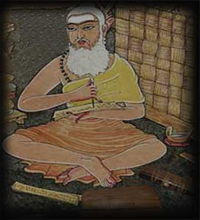 The
origin of the nadi inscriptions can be traced back to approximately
2000 years ago. It is said that the ancient Indian Rishis or sages had
written the life patterns of each person on palm leaves by their Yogic Intuitive powers.
These unique leaves were initially kept in the Saraswati Mahal library
of Tanjore city (Thanjavur ) of Tamilnadu State in India. Later
during the British Rule, the British sold these leaves to the locals
who very very much interested in getting them. People belonging to a
particular sect called the Valluvar community of South India who specialized
in astrology bought most of these leaves. Some of these were also acquired
by the astrology families in Vaitheeswarankoil, a place near Chennai,
the capital of Tamilnadu, a state of India.
The
origin of the nadi inscriptions can be traced back to approximately
2000 years ago. It is said that the ancient Indian Rishis or sages had
written the life patterns of each person on palm leaves by their Yogic Intuitive powers.
These unique leaves were initially kept in the Saraswati Mahal library
of Tanjore city (Thanjavur ) of Tamilnadu State in India. Later
during the British Rule, the British sold these leaves to the locals
who very very much interested in getting them. People belonging to a
particular sect called the Valluvar community of South India who specialized
in astrology bought most of these leaves. Some of these were also acquired
by the astrology families in Vaitheeswarankoil, a place near Chennai,
the capital of Tamilnadu, a state of India.
The leaves were found lying idle in Vaitheeswarankoil aorund the 13th century. Some interested in Astrology realized their values and copied the contents on palm leaves and made exact replicas. These leaves have been handed down over generations to make predictions.
from peacock's blood. The primary centre for Naadi Shastra is in Vaitheeswarankoil, near Chidambaram in Tamil Nadu, a state in South India. Here Lord Shiva is said to have assumed the role of a vaidhya or doctor, who alleviated the miseries of his devotees.